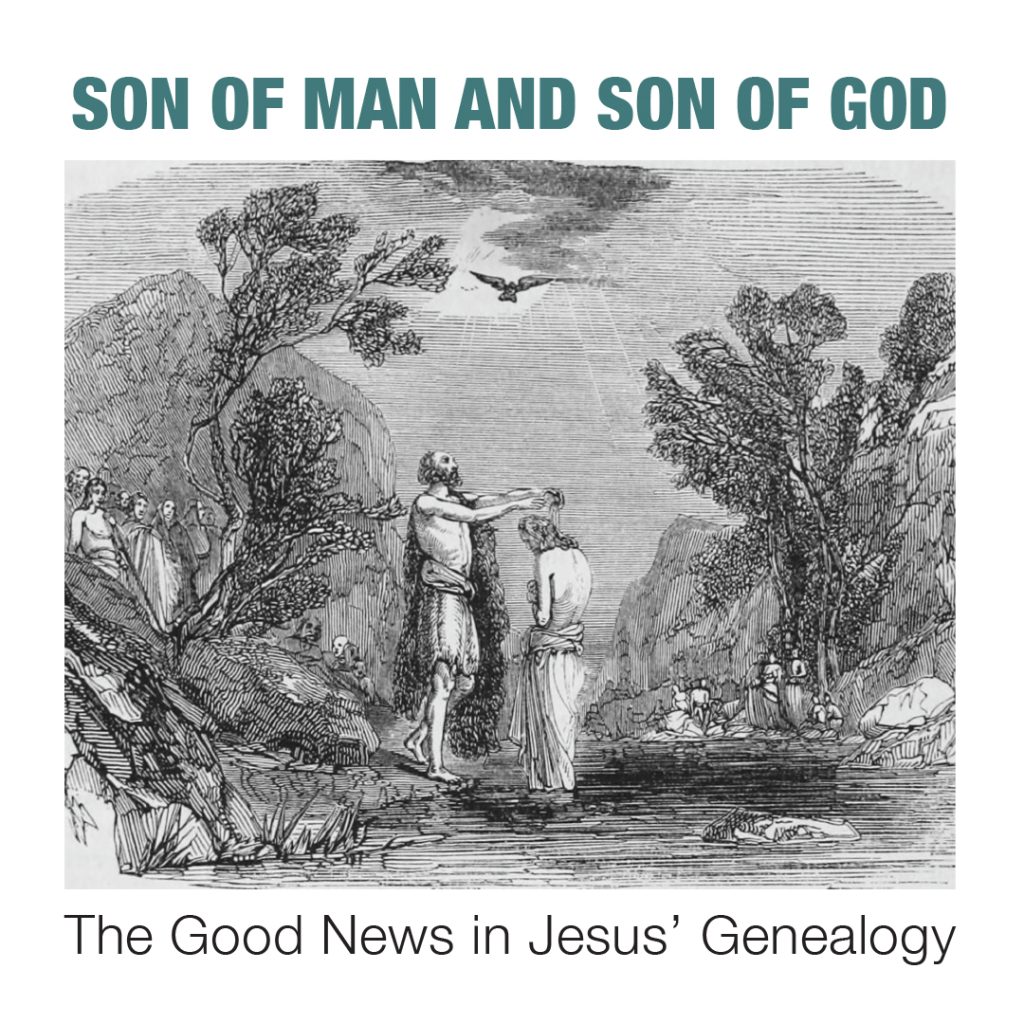Son of Man and Son of God: The Good News in Jesus’ Genealogy

New York, Hewett & Spooner Illustrated New Testament, 1850, via Wikimedia Commons.
by Jonathan Kraemer
When a child is born, parents and others wonder: “What will you be like when you grow up?” or “I wonder how you will take after your mother? Your father?” or “Will you be similar to another relative?” When we ask questions like these, we are curious about the identity of this newborn babe. It is a question that we continue to ask of ourselves through life, even as grown adults: “Who am I?”
Perhaps that is why people in great numbers are paying to have their DNA studied. MIT Technology Review estimated in 2019 that more than 26 million people have had their DNA tested. They also estimated that the growth was so exponential that by now the number could be more like 100 million. Through such studies one can find out about the nature of one’s ancestry, whether someone is predominantly French with some English or Italian thrown into the mix or something else. The assumption is that where we come from tells us something about who we are today.
As we stand at the foot of the manger this Christmas time, we ask of Jesus: “What Child is this?” Of course, we know how things unfolded in Jesus’ life, but Matthew and Luke both thought that Jesus’ family history tells us something important about “the babe, the son of Mary.” Matthew gives the genealogy of Jesus before he gives his account of His birth (Matthew 1:1-17); Luke gives it after, just before the account of Jesus’ ministry (Luke 3:23-38). While we might begin to feel our eyes glaze over when we read these lists of names, they contain some interesting (dare we say scandalous?) facts about Jesus’ family and even some good news for us all.
Jesus, the Climax of History
In Jesus’ genealogy, certain people stand out. Matthew introduces the genealogy as “the book of the genealogy of Jesus Christ, the son of David, the son of Abraham.” He also groups the ancestors into groups of 14 generations: from Abraham to David; from David to the Babylonian Exile; and from the Exile to the birth of Jesus. Abraham and David stand out for good reason: God made significant promises about the Messiah to both of them.
Matthew and Luke both thought that Jesus’ family history tells us something important about “the babe, the son of Mary.”
To Abraham God not only made the promise that He would make him into a great nation and give them the land of Canaan, but He said, “I will make you into nations, and kings shall come from you” (Genesis 17:6). He also promised: “I will bless you and make your name great, so that you will be a blessing. I will bless those who bless you, and him who dishonors you I will curse, and in you all the families of the earth shall be blessed” (Genesis 12:2-3).
With David, God got more specific, promising that, of all the children of Abraham, one particular family would be blessed to rule forever: “When your days are fulfilled and you lie down with your fathers, I will raise up your offspring after you, who shall come from your body, and I will establish his kingdom. He shall build a house for My name, and I will establish the throne of his kingdom forever” (2 Samuel 7:12-13).
With the prominence of Abraham and David in Jesus’ genealogy, Matthew declares that Jesus is the fulfillment of the promises of God for a Messiah, a King. Not only is He a king for God’s people Israel, but through Him all the families of the earth are blessed.
Luke, though He does not specifically highlight Abraham and David, conveys the same thing by tracing Jesus’ family tree to Adam, “the son of God.” In so doing, Luke conveys Jesus’ connection with all people and not just one family. He also introduces Jesus as a second Adam, the greater Adam, the Son of God who will redeem all people.
So, the genealogies place Jesus within a history and context. He has not just recently come on the scene, but has been anticipated and part of God’s plan for centuries. In fact, Jesus is the climax of history, not just for one family but for the world.
Jesus, Relative and Redeemer of Sinners
As we read the genealogy from Matthew, there are a few other names that stand out to us. They are notable because they are particularly notorious. You might even call them skeletons in Jesus’ closet.
First, we read of “Salmon the father of Boaz by Rahab.” If you know Rahab’s history, you will understand why it is controversial to mention her. Rahab was a Canaanite living in Jericho when spies from Israel were first sent to scout out the land. Not only was she a foreigner, but she was also a prostitute. Yes, she aided the Israelites by hiding their spies in her home, but still, she was a Canaanite prostitute.
Rahab is not the only foreigner mentioned in Jesus’ family tree. Right after, we read of “Boaz the father of Obed by Ruth.” Ruth was a foreigner—a Moabite. So, Jesus’ family tree is far from being one “pure” nation descended from Abraham.
It is also far from pure in another way. We have already talked about the prominence of the sinner Rahab in Jesus’ genealogy but we could talk about David too. Yes, he is the receiver of the promise, but he also stands out because of his sin. It says in Matthew 1:6: “And David was the father of Solomon by the wife of Uriah.” The text could have read “by Bathsheba” but instead it says “by the wife of Uriah.” This is an admission of David’s adultery, plain as day. And if you know the story, you also know that David is guilty of more than that; he even plotted to have Uriah killed so he could take Bathsheba as his own wife.
Since Jesus is the sinless Son of God and Son of Man, the Second Adam, He is able to take our place and bear the suffering and pain that our sin deserves. He is our brother and our redeemer.
We could go on and examine each of Jesus’ relatives. The verdict would be the same in every case: guilty! Guilty of sin! In Jesus’ family tree we find that He does not come from a perfect family on his human side. It is every bit as flawed as yours and mine. Generation to generation, all are impure sinners. When Jesus takes on human flesh, He associates with that family… He takes on their DNA.
Jesus’ Father
When it comes to the birth of Jesus, though, there is a difference noted in both Matthew’s and Luke’s genealogies. In Matthew, we read of “Jacob the father of Joseph the husband of Mary, of whom Jesus was born, who is called Christ” (Matthew 1:16). For the first time in this family tree, a man is not described as the father of the child that follows. Joseph is merely called “the husband” of Mary—and it is from Mary that Jesus is born.
Luke is a little more explicit. He says “Jesus… being the son (as it was supposed) of Joseph” (Luke 3:23). Jesus is not, in fact, the natural-born son of Joseph. Since the birth narrative in Luke precedes the genealogy, the reader already knows that Jesus is the sinless Son of God, conceived by the power of the Holy Spirit. Yes, Jesus comes from a long line of sinners, but He is different because He is the Son of God. He is without the sin of His ancestors, though He shares in their life and humanity in every other way.
This is no small fact to be overlooked. Since Jesus is the sinless Son of God and Son of Man, the Second Adam, He is able to take our place and bear the suffering and pain that our sin deserves. He is our brother and our redeemer.
So, as we stand at the manger and behold this newborn at Christmas, His genealogy reminds us that He is the promised king from of old, the fulfillment of the promises to Abraham and David. He is of the family and lineage of David and Abraham, and ultimately Adam. But He is the sinless Son of God, the second Adam who will redeem His family and all the world from their sin.
———————
Rev. Jonathan Kraemer is pastor of All Saints Lutheran Church in Edmonton.



